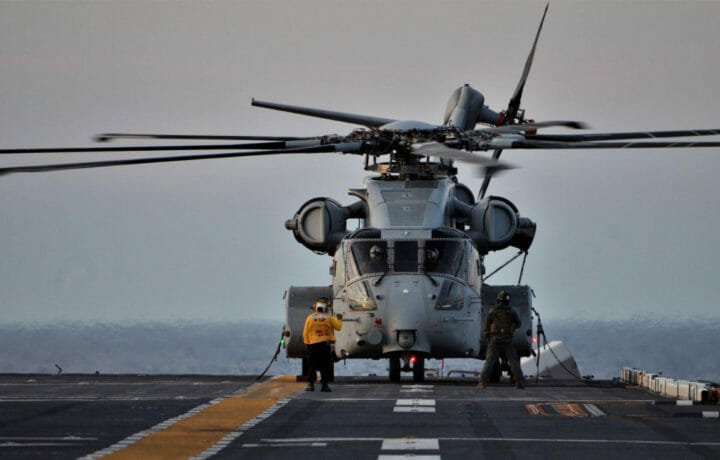In June 2021, Lockheed Martin‘s Sikorsky division was awarded a contract to provide nine additional CH-53K heavy lift helicopters for the United States Navy. The award also included an agreement for the next production contract at an even lower unit price, which could decrease further if additional quantity options were exercised.
Those nine helicopters were part of a 200 aircraft Program of Record for the U.S. Marine Corps for a total of 33 production CH-53Ks under contract with three of the 33 already delivered to the U.S. Marine Corps. Sikorsky had previously announced that it would begin deliveries of the nine additional aircraft in 2024.
The Lockheed Martin business unit received an additional modification for the helicopters from the Naval Air Systems Command, Patuxent River, MD.
The modification has been valued at $27 million and is expected to get completed by April 2025. Per the terms of the deal, Lockheed will be responsible for installing the data transfer unit and Defensive Electronic Countermeasure System Replacement Phase III ARC-210 components into the CH-53K aircraft. Sikorsky will also provide support flight planning and testing of the components and supportability products and a major portion of the work will be executed in Stratford, CT, and Patuxent River.
LRIP and IOC
This past July, Sikorsky announced that it had delivered the third Low-Rate Initial Production (LRIP) CH-53K helicopter ahead of contract schedule to the U.S. Marine Corps. That aircraft, built in the company’s digital factory, was the first CH-53K from the Lot 2 LRIP contract awarded by the U.S. Navy in 2019, and the seventh overall delivered to the fleet.
“This Connecticut-built CH-53K aircraft is a credit to our employees and their skills embracing digital tools and other advanced technologies to continue the Sikorsky legacy of building modern, safe, reliable rotorcraft. Our nationwide supply chain supports the active production line as we prepare to deliver two more CH-53K helicopters later this year,” Bill Falk, director of Sikorsky CH-53K program, said via a statement. “We look forward to continuing our progress toward next year’s full rate production decision.”
This year, the Marine Corps declared Initial Operational Capability (IOC) of the heavy lift aircraft, and it remains on track to deploy on schedule in 2024. To date, the CH-53K has flown more than 3,000 flight hours showcasing the helicopter’s performance in a range of mission scenarios and challenging environments.
A Heavy Lifter
The CH-53K helicopter was designed and built to the exact standards of the U.S. Marine Corps to serve as its critical land and sea-based logistics connector. The new heavy lifter could allow the U.S. Marine Corps and international militaries to move troops and equipment from ship to shore, and to higher altitude terrain, more quickly and effectively than ever before.
In addition, the CH-53K aircraft is developed to be intelligent, reliable, low maintenance, and survivable in the most austere and remote forward operating bases.
The CH‑53K’s heavy-lift capabilities have exceeded all other DoD rotary wing platforms, and it is currently the only heavy-lift helicopter that will remain in production through 2032 and beyond.
Analysts have suggested the development of the chopper could also provide further opportunities for Lockheed Martin to win production and modification contracts for helicopters in recent times, as countries globally have been reinforcing their military resources due to intense geopolitical tensions and amplified terrorist threats.
It was also earlier this year that Sikorsky secured a contract to build a dozen CH-53K heavy lift helicopters for Israel under a U.S. Navy Foreign Military Sales (FMS) agreement. Those will replace the Israeli Air Force (IAF) fleet of modified CH-53D Yasur helicopters, which have been in the Middle Eastern nation’s inventory for more than 50 years.
New Simulators
Beyond the actual helicopters that the Marine Corps will soon be flying, Lockheed Martin has developed specialized training simulators for the aircraft. In August, the defense contractor provided an additional Containerized Flight Training Device (CFTD) to the U.S. Navy with options for three more under the terms of a recent contract award.
That followed up on the success of the first training device delivered in 2020 to Marine Corps Air Station (MCAS) New River in Jacksonville, NC.
The CFTD was developed to offer the capability to train mission scenarios which were then completed during Initial Operational Test & Evaluation (IOT&E). The full-mission flight similar can replicate various environmental conditions in which the aircraft is likely to fly. Training scenarios include day and night air-to-air refueling; air-to-air refueling with 27,000 lb. external load; sea trials with over 350 landings; and operation in Degraded Visual Environments (DVE).
The training device features a full cockpit for the aircraft operated by a pilot and co-pilot, an instructor operating station as well as a brief/debrief room. The newest training devices also feature upgrades that further improve system performance, increase cost savings, and more closely align to the CH-53K aircraft for increased training realism.
“Marine pilots have smoothly transitioned from the training device to the actual CH-53K’s fly-by-wire cockpit and completed missions in the fleet environment – such as air-to-air refueling,” said Flash Kinloch, Lockheed Martin, vice president of Training and Simulation Solutions. “Training in this highly immersive virtual environment permits flight crews to train the full scope of tasks that can be performed on the aircraft in a safe, cost effective and realistic manner.”




